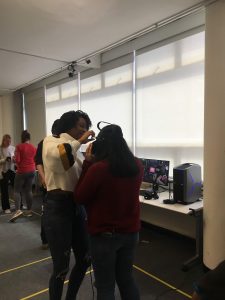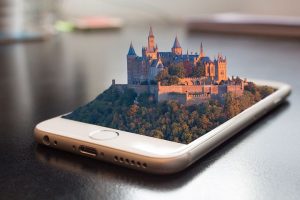Topic:
Virtual reality, which is also referred to as augmented reality, is thought of as a way to escape from reality and view the world through a different lens, both literally and figuratively. The developing industry has the power to change the way we learn about and experience the work around us. One example of a virtual reality device is Oculus Rift, which is owned and operated by Google and offers a different type of interaction with both known and unknown places and people. The development of this product is expanding to become both formal and informal and will be able to present an entire world in one single space.

When I was first introduced to the idea, I was hesitant to immerse myself in virtual reality because of my underdeveloped skills in using it. Since I had not previously been exposed to augmented reality, my initial thoughts about using AR/VR in the classroom were filled with dread. As a current college student, experimenting is relatively common, and while I feared the new technology would be difficult to use, my worries subsided as I realized that virtual reality has a lot to offer students, teachers, and the overall global exposure schools provide students. Augmented reality is intended to be used as a tool for success. The ability to view just about any part of the world is one aspect of augmented reality that I believe to be valuable, and after realizing that AR/VR is designed to do just that, my thoughts prior to learning about augmented reality changed.
Assumptions:
A few assumptions I had about augmented/virtual reality included misconceptions on the purpose of the technology. I believed that because of the high price tag on virtual reality, the feasibility and applicability it had to the classroom would be minimal. I also assumed that using virtual reality in the classroom would be easy if it was employed, but I quickly observed from two sessions in DH Hill’s VR Lab that controlling a large group of students with headsets on would be very difficult in and of itself. My assumptions stemmed from my inexperience with the technology, mostly due to my lack of exposure to the benefits and drawbacks of supporting the employment of augmented reality in education. Before learning more about the subject, I imagined that I would not use augmented reality again after learning about it in class, especially not in my future classroom.

In evaluating my previous assumptions, I can now recognize the flaws in my thoughts. Although augmented reality can be expensive and entertaining, the possibility that students have to travel the world without having to leave a classroom is incomparable to anything in a classroom today. Furthermore, by providing students with the ability to explore the world and different aspects of their imagination more deeply, the education system is setting up future generations for success in pursuing interests and passions beyond the classroom walls.
Learn more about how virtual reality will drive deeper learning!New Ideas:
While learning about virtual reality and the perks of using in for education, I also learned about the possible drawbacks associated with using this technology in the classroom. Through virtual reality, there is a possibility for bridging the divide in learning styles. Additionally, there is potential to relieve test-taking anxieties by adapting to the learning style of each individual user. Today, students are disadvantaged in the classroom because they learn in different ways, not directly associated with the intelligence of that student. Those who learn in ways not practiced in a traditional classroom become frustrated and lost as they continue to fall farther behind peers and are flagged as low performers. Integrating virtual reality into the classroom could be a game changer because of the opportunity students are given to learn from interactions and applicability rather than simply reading from a book.
Additionally, as virtual reality presents new examples for how it can revolutionize teaching in both diversity and inclusion, the new technology is more likely to be integrated into schools and allow more students to experience the world in ways they would not otherwise be able to.
A Course of Action:
I imagine that I will use virtual reality as a tool for creativity for students to be given the chance to create their own virtual reality tour of a place they are interested in visiting. In addition to providing students with access to a new resource, I believe using current technology will benefit myself and my students in adequately preparing students for being strong digital citizens. By being oriented with the latest technological breakthroughs as well as harboring creativity and curiosity, virtual reality offers much more than just entertainment and engagement for students, it offers a new perspective that connects how academic content applies to the real world.
Pros and Cons of VR
Moreover, I believe students of all ages and socioeconomic backgrounds could build on their understanding of communication, collaboration, critical thinking, and creativity through virtual reality. Whether the experience develops from sightseeing in countries around the globe or from creating a virtual tour with a classmate on a foreign country for a project, virtual reality harnesses the skills of the twenty-first century and allows students to develop an enjoyment of learning in their own way, which is why I believe I will incorporate virtual reality in my teaching career.


Learned:
After indulging in all that augmented reality has to offer, I confidently conclude that as a prospective teacher, this resource is one with immeasurable benefits. Having the ability to immerse children in their own curiosity and wonder is an aspect of education that is currently lacking, and virtual reality is working to mend that. By further exploring the possibilities that augmented reality brings to the table for education, I hope to see those offers put to action in the coming years. Either in the form of test-taking strategies or just for fun, virtual reality is an innovative way to push children to be children while also learning in an exciting way. Throughout the process of studying virtual reality, I have learned that education is about much more than accumilating knowledge, its about applying that knowledge and making connections on how something learned is valuable in the real world.
